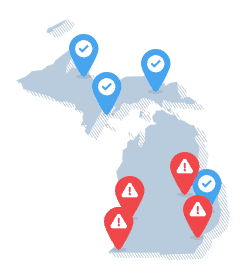The Safest and Most Dangerous Cities in Michigan

Michigan Security Solutions
The following is a list of cities that provide home security solutions in the state of Michigan
Michigan boasts a variety of settings, from the Upper Peninsula's natural beauty to Detroit's famous Motor City heritage. Having said that, the state's crime scene appears to mirror these same disparities. According to FBI data, Michigan was ranked 38th for property crime and 10th for violent crime in the country in 2023. Certain cities like Gladstone and Rochester had exceptionally low crime rates but other cities like Benton Harbor and Roosevelt Park had rates that were significantly higher than the state and federal averages. These patterns highlight the influence of geography, local culture and economics on public safety.
Best and Worst Cities for Property and Violent Crime
Cities in Michigan have quite different crime patterns, with some having far greater rates of violent and property crime than others. Based on information from the FBI’s Uniform Crime Reporting (UCR) Program, we will examine the top and worst cities for violent and property crimes in this section. We will investigate the cities with the highest and lowest rates in greater detail and discover the fundamental causes of crime and safety in the Great Lakes State.
Michigan cities with the highest and lowest crime rates
(per 100,000 people)
| Cities with the highest property crime rates | |
|---|---|
| Roosevelt Park | 7,139 |
| South Haven | 6,123 |
| Birch Run | 5,970 |
| Cities with the highest violent crime rates | |
|---|---|
| Benton Harbor | 2,300 |
| Saginaw | 2,264 |
| Detroit | 2,052 |
| Cities with the lowest property crime rates | |
|---|---|
| Ishpeming Township | 58 |
| Kinross Township | 77 |
| Croswell | 86 |
| Cities with the lowest violent crime rates | |
|---|---|
| Gladstone | 19 |
| Lapeer Township | 20 |
| Rochester | 24 |
Note: Excluding cities with crime rates of zero. Source: 2023 FBI Data
High-Crime Cities: What the Numbers Reveal
The small Lake Michigan city of Benton Harbor had the highest violent crime rate in Michigan in 2023. The number of incidents in Benton Harbor was an astounding 2,300 per 100,000 inhabitants. Saginaw, a smaller city, ranked second with 2,264 incidents per 100,000 inhabitants. Detroit has a well-known reputation for having high crime rates. With 2,052 incidents per 100,000 residents, it had the third-highest violent crime rate in all of Michigan.
The high crime rates in these three cities might be the result of their shared history of long-term economic hardship and high rates of poverty. These conditions are frequently linked to an increase in violent crime, especially aggravated assault, which was the most prevalent violent crime in the state.
With an incredible 7,139 property crime incidents per 100,000 residents, Roosevelt Park ranked highest on the list for property crime. South Haven had 6,123 incidents per 100,000 residents and Birch Run had 5,970 incidents per 100,000 residents, rounding out the top three.
Tourist activity is probably contributing to these figures for these three cities. Situated on the shores of Lake Michigan, South Haven is a well-liked summer vacation spot. The likelihood of theft, burglary and auto theft tends to increase when the number of visitors is higher than the number of permanent residents.
Low-Crime Cities: Michigan’s Hidden Gems
Conversely, which Michigan cities are the safest? The Upper Peninsula brings us the safest city for violent crimes, with Gladstone having just 19 violent crimes for every 100,000 inhabitants in 2023. Lapeer Township (20) and Rochester (24) in the Lower Peninsula were not far behind, both of which had remarkably low rates of violent crime.
What is causing these kinds of low numbers? These cities all have tight-knit social structures, smaller populations and stronger economic indicators. These factors are all frequently linked to lower crime rates, especially when taken together and their numbers demonstrate this.
Michigan residents will once more need to travel to the Upper Peninsula to avoid high rates of property crime. Ishpeming Township (58) and Kinross Township (77) are both in the Upper Peninsula. Croswell (86), which is situated more in the lower Michigan thumb, comes in third.
These three communities are all situated far from any significant cities. They frequently see a decrease in transient activity, which also helps to lower rates of property crime.
Statewide Crime Trends Analysis
With a violent crime rate of 457 incidents per 100,000 residents, Michigan is ranked 10th in the country for violent crimes and its violent crime rate is 26% higher than the national average. Hearing that may be depressing, but there is still hope. The 2023 crime rate is 0.8% lower than the previous year.1
Violent crime rates
(per 100,000 residents)
| Crime Type | Michigan | National |
|---|---|---|
| Murder | 5.9 | 5.7 |
| Aggravated assault | 355.5 | 263.7 |
| Robbery | 36.9 | 65.4 |
| Rape | 58.9 | 38.0 |
The most common violent crime in Michigan is aggravated assault, with 355.5 incidents per 100,000 residents. Additionally, this rate is 34.6% higher than the national average. With 58.9 cases of rapes occurring for every 100,000 residents, it is also one of the most common violent crimes in Michigan. Compared to the national average, this rate is 55% higher. These greater rates may be attributed to local reporting procedures, inadequate funding for victim services or problems with domestic violence.
Property crime rates
(per 100,000 residents)
| Crime Type | Michigan | National |
|---|---|---|
| Burglary | 205.2 | 250.7 |
| Larceny | 1,060.0 | 1,343.9 |
| Vehicle theft | 281.3 | 317.2 |
Meanwhile, Michigan ranks 38th in the country for property crime with 1,547 incidents per 100,000 residents, which is 19% lower than the national average. When compared year-over-year, it did see an increase of 0.6%.
The most frequent property crime in Michigan is larceny-theft, which accounts for the majority of incidents with a rate of 1,060 per 100,000 residents. This is still 21.3% lower than the national average. Michigan’s motor vehicle theft and burglary rates are also below average, suggesting that although the state is dealing with violent crime, its property crime situation is relatively stable.
What Factors Contribute to Crime in Michigan?
Michigan's distinct socioeconomic structure may be the cause of the state's high violent crime and low property crime rates. Based on data from the United States Census Bureau, many cities with high rates of violent crime are also economically distressed and have sizable populations of historically marginalized communities.
Detroit, for example, has long represented both post-industrial struggle and industrial success. Violent crime rates frequently rise when segregation, chronic poverty and inadequate policing are combined.
Conversely, the state’s lower-than-average rates of property crime could be attributed to a number of factors. For starters, compared to other states with higher populations, Michigan has fewer big dense cities, which may help stop the spread of property crimes.
Many of the low-crime cities in Michigan are found in rural and suburban areas. Higher homeownership and community cohesion rates are common in these areas and both are known to discourage crimes, such as burglaries and theft.
Conclusion: A Tale of Two Michigans
In terms of crime, Michigan is a contradictory state. High-crime areas like Roosevelt Park and Benton Harbor appear to urgently need intervention, but communities like Gladstone and Ishpeming Township offer us a glimpse of what can happen when community, geographic and economic factors come together to support public safety.
Examining the subtleties of the data helps residents, legislators and law enforcement see things more clearly. While the state may be facing an uphill battle in tackling violent crime, the relatively low property crime rates offer a glimmer of hope and could be a model for other states to follow.
Where Our Crime Data Comes From
Unless specified otherwise, the information in this article is based on crime data compiled by the FBI and made available through the Crime Data Explorer. Statewide violent and property crime statistics are drawn from the FBI’s 2023 Crime in the United States Report (Table 5) and, for city-level crime rates, we referred to Table 8, which lists reported offenses by state and city.
Important note: Crime statistics offer valuable insights, but they aren’t the only way to evaluate a community’s safety. Local context, law enforcement practices and reporting standards can all influence how crime is recorded. Additionally, FBI publication tables and the data displayed on the Crime Data Explorer may differ slightly due to variations in methodology.
Navigate Crime Data by State
- Alabama
- Alaska
- Arizona
- Arkansas
- California
- Colorado
- Connecticut
- Delaware
- Florida
- Georgia
- Hawaii
- Idaho
- Illinois
- Indiana
- Iowa
- Kansas
- Kentucky
- Louisiana
- Maine
- Maryland
- Massachusetts
- Minnesota
- Mississippi
- Missouri
- Montana
- Nebraska
- Nevada
- New Hampshire
- New Jersey
- New Mexico
- New York
- North Carolina
- North Dakota
- Ohio
- Oklahoma
- Oregon
- Pennsylvania
- Rhode Island
- South Carolina
- South Dakota
- Tennessee
- Texas
- Utah
- Vermont
- Virginia
- Washington
- West Virginia
- Wisconsin
- Wyoming
Citations
- Bridge Michigan. (2024, Feb 15). Crime fact check: Violence fell 23%, but is still high in many Michigan cities.
https://www.bridgemi.com/michigan-government/crime-fact-check-violence-fell-23-still-high-many-michigan-cities
